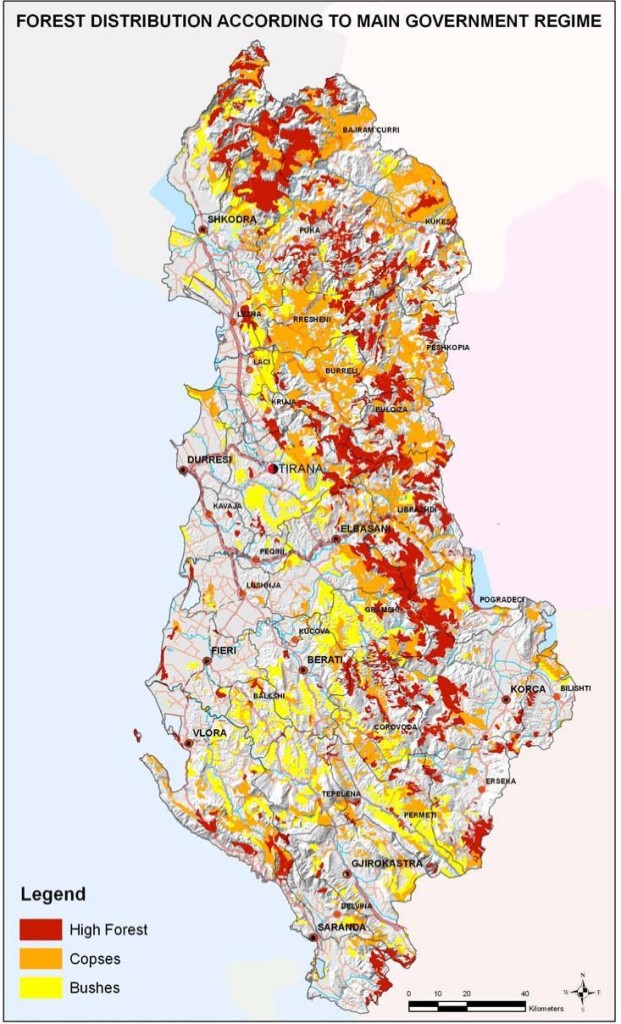Albania Biomass
The term biomass covers a wide variety of both fuel and conversion technologies. Usually, the term biomass refers to woody or agricultural products being converted into useful energy through different conversion technologies (Ecofys BV 2006). Biomass often refers to solid materials such as wood, branches, industrial wood waste, urban solid waste and agricultural residues (agriculture plants, animal feeding); whereas bio-fuel refers to the (final) products that are liquids. Important conversion technologies are: Burning, incineration, Gasification, Digestion
Background
For ages, Albanians rely on fuel wood for cooking their food and heating their homes. Therefore, there is nothing new about biomass resources. However, it is the conversion technology and the size of these different new technologies that make things new. Biomass can be used as fuel for power plants (electricity), heat boilers (heat) and cogeneration (both heat and electricity). New plants can be constructed, but biomass can also replace coal (lignite, anthracite) in existing power stations, up to a certain percentage. Especially older power stations, which can deal with a variety of fuel qualities, might well be able to deal with biomass, next to fossil fuels such as lignite and anthracite. The term is then ‘co-firing’.
Potential
Biomass resources, woods, are plentiful available in Albania, especially in the mountainous regions. This does not mean automatically, though, that the potential for biomass is high. The woods are protected and/or part of nature reserves, or there are claims from logging/building/furniture industries. This means, woods have other economical and nature reserves, more important than those as biomass. On the European market, we see therefore that secondary woody materials are more and more being utilized as biomass, for example by compacting (pelletising or briquetting) sawdust or wood chips into a uniform product that can be traded in Europe and possibly worldwide (Ecofys BV 2006). Obviously, concerns about selling out the woods should be dealt with; the sustainability of woods and the contribution to biodiversity could be at stake. Woods and forests should be treated as natural reserve. An example to combat the abuse of woods is the introduction of the FSC label (‘Forestry Stewardship Council’), with which woods can be exploited for the different purposes, and still have enough time to be regenerated once the trees are felled.
According to some approximate estimation, the energy potential from agricultural residues were calculated at approximately around 800 toe/year in 1980; while in 2001 were around 130 toe/year. The potential of urban wastes from the main Albanian cities was calculated as approximately 405615 ton oil equivalent (Toe), predicted for the year 2010 (EBRD 2004).
The wood sources in Albania are concentrated in the forestry zones that cover around 38.2% of the total surface. The data on forest resources are based on inventories done every 10 years from the Forestry Directorate subordinated to the Ministry of Agriculture. Total forecasted resources reach some 125 million m3 (14.3 toe). Forests are classified in these major categories: high forests which represent 47-50% of the total wood resources; copses which are 29-30% of the total resources; and bushes, which are 24-25% of the total wood resources. From the three aforementioned categories, 10% of high forests, 50% of copses and 100% of bushes are used as fuel wood. From this data, proven resources of fuel wood are respectively 5.87, 18.25 and 30 million m3. The total proven reserves of fuel wood are considered about 6 Mtoe (Hizmo 2006).
The energy potential from animal residue’s as well as for agricultural residue potations is calculated at approximately 70 [toe/year] 12 740 GJ in 1995 with a trend to be increased in the future. These numbers should be considered estimates; a more comprehensive study should be carried out for real validation.
Installed capacity
It is expected that, apart from a wide variety of old wood stoves and furnaces working on wood, several modern wood boilers are in operation, possibly at wood industry locations, to heat production halls and facilities. The increase of the biomass contribution is primarily based on a more efficient use of the fire wood. The actual average yield of fire woods is 35-40%. It is foreseen that in 2025 Albania will have a penetration of family market heaters with an average yield of 75-85%.
Characteristic features for Albania
As a rugged country, with limited fossil fuel resources (lignite), and an economy that is still close to its agricultural roots, there are good opportunities to develop the biomass potential much further. Environmental concerns should be taken care of, in order not to have a continuous and clean supply of indigenous energy and to prevent a sell out of the natural resources of the country.
Actually, from the categories mentioned above, the wood waste from the wood industry and solid urban waste biomass can be of a considerable contribution. Biomass from the agriculture is connected with agricultural plants being used to feed the animals during winter time.
A biomass group, which can be very profitable, consist of the cores of olive, peaches, etc. These cores that are waste of alimentary industry can be burnt supplying warm water or steam for different technology processes in the alimentary industry. The biomass from the so-called energetic plants is not applied yet in Albania. It still needs to be stressed the importance of the incentive policies on the application of these kinds of plants.
Another important group that can be taken into consideration on the energy supply is the high richness of bushes. They can be considered without any doubt, as a very good source of renewable energy, as they will always be growing up. Whereas biomass produced from the animal breeding can not be taken into consideration due to a low number of the house animals and lack of division of farms (a farm consist of a very small number of cows and other animals) and a small amount of waste, which actually are being used as organic fertilizer.


